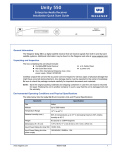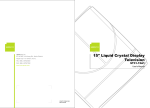Download SRS Labs WT01-15A1 User's Manual
Transcript
15" Liquid Crystal Display Television R eG WT01-15A1 User's Manual Batman NTSCTVTWEN1203 MAC-001138 Table of Contents 1. 2. 3. 4. 5. 6. Warranty and Service .................................................... 3 Preface ......................................................................... 4 Description of Warning Symbols ..................................... 5 Safety Notices ............................................................... 6 Regulatory Information ................................................ 14 Introducing the TV ....................................................... 16 Features .................................................................. 16 7. Checking Package Contents ........................................ 17 8. Getting to Know Your TV ............................................. 18 Front View ............................................................... 18 Input and Output Ports ............................................. 19 9. Getting Started ............................................................ 21 Connecting to an Antenna or Cable TV ..................... 21 Connecting to AV Devices ........................................ 22 Connecting to a VCR/VCD/DVD Player ................ 22 Connecting to a Video Camera ............................ 23 Connecting to a Game Device ............................. 24 Connecting External Speakers or Headphones .......... 25 Connecting to a PC .................................................. 26 Connecting the Power Adapter ................................. 27 10. Using the TV .............................................................. 28 Using the Remote Control ........................................ 28 Turning the TV On and Off ....................................... 29 Selecting Channels .................................................. 29 Switching Source Signals ......................................... 30 Adjusting the Volume ............................................... 30 11. Adjusting On-Screen Display (OSD) Settings ............... 31 Brightness ............................................................... 32 Contrast .................................................................. 33 Audio Setting ........................................................... 34 Treble ................................................................. 35 Bass ................................................................... 36 Balance .............................................................. 37 SRS ................................................................... 38 1 Table of Contents 12. 13. 14. 15. 2 Mute ................................................................... Video Setting ........................................................... Hue .................................................................... Saturation ........................................................... Sharpness .......................................................... Color Temperature .............................................. TV Setting ............................................................... TV/CATV ............................................................ MTS ................................................................... Auto Program ...................................................... Manual Program .................................................. Channel Add/Erase ............................................. PC Setting ............................................................... Horizontal Position .............................................. Vertical Position .................................................. Phase ................................................................. Clock .................................................................. Color Temperature .............................................. Miscellaneous Setting .............................................. Language ........................................................... Sleeper ............................................................... OSD Display ....................................................... Time Setting ....................................................... OSD Background ................................................ Reset ................................................................. Taking Care of Your TV .............................................. Troubleshooting .......................................................... Specifications ............................................................. Glossary .................................................................... 39 40 41 42 43 44 45 46 47 49 50 51 52 53 54 55 56 57 59 60 61 62 63 64 65 67 68 70 71 1 Warranty and Service The instructions on this manual are for the model(s) listed on the front cover. Before you start reading, check your product number by looking at the rear of your TV. Thank you for purchasing our Liquid Crystal Display Television (LCD TV). With this product, you will be able to enjoy superior audio and video while enriching your lifestyle with advanced technology. The Hannspree TV is warranted for one year limited service from the date the product is received (as shown on the Warranty and Service Manual); please refer to the “Warranty and Service Manual” for the detailed warranty information. Hannspree provides complete service information in the included “Warranty and Service Manual”, or directly from Hannspree global customer service center. Our service representatives will be very happy to serve you to your satisfaction. Hannspree global customer service center telephone number: From Taiwan please call 0800-008-800 Hannspree e-mail address: [email protected] 3 2 Preface This manual is designed to assist users in setting up and using the LCD TV. Information in this document has been carefully checked for accuracy; however, no guarantee is given to the correctness of the contents. The information in this document is subject to change without notice. Copyright © Copyright 2003 Hannspree, Inc. All rights reserved. This product and related documentation are protected by copyright and are distributed under licenses restricting their use, copying, and distribution. No part of this documentation may be reproduced in any form by any means without prior written authorization of Hannspree, Inc., and its licensors, if any. 4 3 Description of Warning Symbols Warning Caution This symbol is used to remind users to pay attention to important descriptions regarding usage and maintenance (repair) or additional important information related to this product. This symbol is used to remind users to pay attention to the danger of electric shocks due to dangerous internal noninsulated components. Electric Power Notice Electric power may cause personal injury and mechanical damage if it is misused. Although safety has been taken into consideration during the design and production of this product, electric shock or fire can result when the product is misused. To prevent potential danger, follow the instructions below when installing, operating and cleaning the product. In addition, read the following “Safety Notices” carefully before using the product to ensure that your TV is safe and long-lasting. 5 4 Safety Notices Power Supply Safety Notes 1. To avoid electric shocks, do not use an extended power cord or an outlet that does not match this product's plug or leaves the plug exposed. 2. This product has a 3-pin grounded plug. The third pin connects to ground; do not remove it. 3. If the power cord or plug is damaged or worn, unplug it immediately and contact a qualified service technician for maintenance. 4. To avoid fire or electric shocks, do not overload electric power outlets. Installation Safety Notes Antenna We suggest that you use an outdoor antenna to get the best signal possible unless you have cable TV or a centralized indoor antenna system. You may, however, use an antenna indoors if it is placed in a location free from interference. Location Avoid allowing the TV to get prolonged exposure to sunlight or other strong sources of heat. Leave sufficient distance between the TV and the wall to provide enough space for the emission of heat. 6 Before You Proceed 1. Read the Safety Notices and the User’s Manual carefully before turning the product on. 2. Keep your User’s Manual in a safe place for future reference. Keep the box and packaging in case the product needs to be shipped in the future. 3. Follow the product and warning label instructions. 4. Any changes or modifications that do not follow the instructions in this manual will void this product's warranty. Warning To reduce the risk of fire or electric shock, do not expose this product to rain or moisture. Power To avoid danger of fires or electric shock, make sure that you use a proper adapter. The TV is compatible with the following adapters: • EDAC POWER ELECTRONICS CO., LTD.: EA 1050A-120 • LI SHIN INTERNATIONAL ENTERPRISE CORP.: 0218B1260 7 Optimal Viewing Distance 160 CM 1 8 Important Safety Instructions 1. Read these instructions. 2. Keep these instructions. 3. Heed all warnings. 4. Follow all instructions. 5. Do not use this apparatus near water. 6. Clean only with a dry cloth. 7. Do not block any ventilation openings. Install in accordance with the manufacturer’s instructions. 8. Do not install near any heat sources such as radiators, heat registers, stoves, or other apparatus (including amplifiers) that produce heat. 9. Do not defeat the safety purpose of the polarized or grounding-type plug: A polarized plug has two blades with one wider than the other. A grounding type plug has two blades and a third grounding prong. The wide blade or the third prong are provided for your safety. If the provided plug does not fit into your outlet, consult an electrician for replacement of the obsolete outlet. 9 10. Protect the power cord from being walked on or pinched particularly at the plug, convenience receptacles, and the point where they exit from the apparatus. 11. Use only with a cart, stand, tripod, bracket, or table specified by the manufacturer, or sold with the apparatus. When a cart is used, use caution when moving the cart/apparatus combination to avoid injury from tip-over. 12. Only use attachments/accessories specified by the manufacturer. 13. Unplug this apparatus during lightning storms or when unused for long periods of time. 14. Refer all servicing to qualified service personnel. Servicing is required when the apparatus has been damaged in any way, such as if the power-supply cord or plug is damaged, liquid has been spilled or objects have fallen into the apparatus, the apparatus has been exposed to rain or moisture, does not operate normally, or has been dropped. 10 Personal Safety To avoid overloading the power supply, do not plug too many electrical devices into an outlet or extension cable. Dangerous high-voltage electric power components are located inside the TV. To avoid electric shock, do not disassemble the casing. Do not place or drop metals, small objects, or flammable materials in the vent to avoid an electric shock or a fire. If the TV is dropped, falls down, or is otherwise damaged, unplug the power cord immediately and notify a qualified service technician. If any fluid is sprayed or dropped into the TV, remove the power plug immediately and notify a qualified service technician. The screen of the TV is made of glass, be careful to avoid hitting or scraping it. If the screen is broken, avoid cutting yourself on the broken glass. Do not allow children to use the TV unattended to avoid accidents caused by improper operation. 11 Installation To avoid damage to power circuits, do not place the TV in locations where there is excessive steam or dust. Do not place the TV on a bed, sofa, carpet, or in a sealed cabinet to avoid blocking the product's vents. Install the outdoor antenna far from power transmission lines to avoid possible danger. Remove the power cord and antenna connector when there is a storm or when the TV is not in use for a long period to avoid electric shock from lightning. 12 Operation V This product is designed for power sources as labeled on the casing. Avoid using any other power accessories to avoid electric shock or other damage. The plug can be inserted into an outlet in only one direction. Notify a qualified service technician if you cannot plug it in correctly. If there is any problem that cannot be resolved according to the instructions given in this manual, notify a qualified service technician immediately. Do not attempt any methods not covered in this manual. Maintenance Do not attempt to repair the TV by yourself. Notify a qualified service technician. Ask the service technician to complete a safety inspection before switching the power on after completing any maintenance. 13 5 Regulatory Information FCC Compliance Statement1 This device complies with part 15 of the FCC Rules. Operation is subject to the following two conditions: (1) This device may not cause harmful interference, and (2) this device must accept any interference received, including interference that may cause undesired operation. This equipment has been tested and found to comply with the limits for a Class B digital device, pursuant to part 15 of the FCC Rules. These limits are designed to provide reasonable protection against harmful interference in a residential installation. This equipment generates, uses and can radiate radio frequency energy and, if not installed and used in accordance with the instructions, may cause harmful interference to radio communications. However, there is no guarantee that interference will not occur in a particular installation. If this equipment does cause harmful interference to radio or television reception, which can be determined by turning the equipment off and on, the user is encouraged to try to correct the interference by one or more of the following measures: • • • Reorient or relocate the receiving antenna Increase the separation between the equipment and receiver Connect the equipment into an outlet on a circuit different from that to which the receiver is connected Consult the dealer or an experienced radio/TV technician for help • Warning: A shielded-type power cord is required in order to meet FCC emission limits and also to prevent interference to nearby radio and television reception. It is essential that only the supplied power cord be used. Use only shielded cables to connect I/O devices to this equipment. You are cautioned that changes or modifications not expressly approved by the party responsible for compliance could void your authority to operate the equipment. 1. applies only to products purchased in the United States of America 14 DOC Compliance Notice1 This digital apparatus does not exceed the Class B limits for radio noise emissions from digital apparatus as set out in the Radio Interference Regulations of the Canadian Department of Communications.This device complies with Canada ICES-003 Class B. CE Conformity Statement2 This device complies with the requirements set out in the Council Directive on the approximation of the Laws of the Member States relating to Electromagnetic Compatibility (89/336/EEC) and the Amendment Directive (92/31/EEC), Low-Voltage Directive (73/23/EEC) and the Amendment Directive (93/68/EEC). 1. applies only to products purchased in Canada 2. applies only to products purchased in the European Union 15 6 Introducing the TV Thank you for purchasing this 15-inch Liquid Crystal Display TV. Your LCD TV is designed to be safe, versatile, and easy to use. The design of the product is based on Batman, which makes it a fun addition to any room. You can watch broadcast or cable television channels, and easily connect a VCR, VCD or DVD player or a game device to the standard RCA and SVideo input ports that are included in the 4-IN-1 cable. You can also connect your TV to a PC and use the TV as an external monitor. Convenient control buttons located on the front panel and a handy remote control let you change channels, adjust the volume, and change display settings through an easy-to-use on-screen menu system. The built-in stereo speakers provide full rich sound and a convenient audio output port lets you connect to an external audio system or headphones. Features • • • • • • 15-inch color TFT LCD TV Safe and sturdy construction Built-in TV tuner 4-IN-1 cable On-Screen Display (OSD) menu system Built-in 3W+3W speakers 16 7 Checking Package Contents Make sure the following components are included in the box. Contact your vendor immediately if anything is missing or damaged. TV User’s Manual Quick Start Guide User's Man ual Warranty and Service Manual Quick Sta Guide rt Warranty and manual service Wire Material Package 4-IN-1 Cable RCA Jack x 3 874 Power Adapter E77 Power Cord W -1 VGA Cable V 0V G W A 1 8 30 80 C 17 8 Getting to Know Your TV Front View Signal sensor 7 8 8 1 Description 1 Adjust volume 2 Menu 3 Source 4 Power 5 Auto/Mute 6 Select channel 7 8 Power LED Stereo speakers 18 2 3 4 5 6 Function Press VOL < to increase the audio volume. Press VOL > to decrease the audio volume. Turns the On-Screen Display (OSD) menu on and off. Selects the input source to be displayed (TV/CATV, AV1, AV2 or PC ). Turns the TV on and off. Automatically adjusts the screen parameters in PC mode. In TV/AV mode, press this button to mute the audio. Changes channels. Press CH > to increase the channel number. Press CH< to decrease the channel number. In PC or AV mode, press either button to return to TV mode. Green LED indicates power on. Play audio content. Input and Output Ports R 1 2 3 4 5 6 7 Description L 8 9 10 Function 1 LINE OUT Connects to external amplifier or speakers. 2 DC 12V Connects to the included power adapter. 3 LINE IN Connects to a PC's DVI port. 19 4 AV2 Use the included 4-IN-1 Audio/Video cable to connect external devices, such as a VCR, VCD, or DVD player. Audio Input: AV connectors white and red audio cables. Video Input: AV connector video (yellow) or S-Video cables. 5 HEADPHONE Connects to headphones. 6 R-AUDIO Connects to a right audio (red) cable 7 VGA Connects to a PC. 8 L-AUDIO Connects to a left audio (white) cable 9 ANT Connects to an antenna or CATV cable television line. 10 VIDEO Connects to a video (yellow) cable 20 9 Getting Started Connecting to an Antenna or Cable TV 1 Connect one end of the UHF or CATV cable to ANT Jack (VHF/UHF IN Jack) on the back of the TV. 2 Connect the other end of the VHF/UHF (Antenna) or CATV cable to the antenna socket or CATV cable. Antenna R ANT jack (VHF/UHF IN jack) L Antenna/CATV socket Antenna/CATV coaxial cable Note If you cannot receive channels after connecting to an antenna or cable TV line, try scanning for channels. See “Auto Program” on page 49. 21 Connecting to AV Devices Connect external devices such as a VCR, VCD or DVD player, or video game to the TV using the 4-IN-1 cable. Connecting to a VCR/VCD/DVD Player The illustration presented here shows how to connect the TV to a VCR, VCD or DVD player. Actual connections may vary according to the make and model of the device. Refer to the user’s manual included with the device for more detailed instructions. VCR DVD VCD R L B R W Y 4-IN-1 jack S-Video connector AV connectors 4-IN-1 cable Note The cables are color-coded (black, red, white, yellow). Connect each colorcoded cable to the appropriate connector on your device. 22 Connecting to a Video Camera The instructions presented here are a general guide to connecting the TV to a camcorder or other type of digital camera. Actual connections may vary according to the make and model of the device. Refer to the user’s manual included with the camcorder or camera for more detailed instructions. WB R S L 4-IN-1 jack S-Video connector B R W 4-IN-1 cable Y AV connectors Note The cables are color-coded (black, red, white, yellow). Connect each colorcoded cable to the appropriate connector on your device. 23 Connecting to a Game Device The instructions presented here are a general guide to connecting the TV to a game device using the RCA Jacks provided (some game devices may require a unique adapter that is not provided). Actual connections may vary according to the make and model of the game device. Refer to the user’s manual included with the game device for more detailed instructions. R L B R W Y 4-IN-1 jack S-Video connector AV connectors 4-IN-1 cable Notes • Connect the 4-IN-1 cable connectors to the corresponding connectors on your game device adapter. • If the 4-in-1 cable does not fit the game device, then insert the included RCA jack between the 4-in-1 cable and game device. 24 Connecting External Speakers or Headphones External speakers or headphones may be used to listen to the TV rather than using the built-in speakers. Connect external speakers or headphones to the speaker line out port as illustrated. Headphones R L Speakers Speakers line out port Headphone Notes • External speakers or headphones are not included with the product. • The internal TV speakers will not output sound when headphones are plugged in. • Use external speakers with amplifiers only. 25 Connecting to a PC You can connect the TV to a PC and use it as an external monitor. Connect the TV’s VGA port to the PC’s VGA port. Connect the TV’s line in port to the PC’s line out port to listen to the PC’s audio output on the TV’s speakers. Refer to the following illustration. R Line in L VGA port VGA port Line out Note You can connect the line out port of a CD-ROM player, stereo, or other device to the TV’s line in port to listen to the devices audio output. 26 Connecting the Power Adapter 1 Connect the power cord to the power adapter as illustrated. 2 Plug the power adapter connector into the DC-IN input jack on the rear panel of the TV. 3 Insert the three-pronged plug at the other end of the power cord into a power outlet. Power outlet Three-pronged plug R L Power cord DC-INDC-IN input jack Power adapter 27 10 Using the TV Using the Remote Control For best results, use the remote control within a distance of 5 meters from the front of the TV’s signal sensor. Do not exceed an angle of 30 degrees when pointing at the signal sensor. Refer to the following illustration. 28 Turning the TV On and Off 1 Press the POWER button on the remote control (or control panel). The power LED on the front of the TV changes from red to green, indicating that the power has been turned on. Power button/ Power LED 2 Press the POWER button again; the power LED changes from green to red, indicating that the TV is in off mode. When signal is not detected in PC mode, the power LED turns amber, indicating that the PC is in standby mode. Selecting Channels Press CH UP or CH DOWN button on the control panel to select the channel or enter the specific channel number buttons on the remote contorl. Channel down Channel up 29 Switching Source Signals Press SOURCE to select the in coming source signal.. The current source setting (TV/CATV, AV1, AV2 or PC ) appears on the upper left corner of the screen. 40 Note Source The TV supports S-Video input in addition to normal video and audio signals. The TV detects the signal type automatically and gives priority to S-Video when two signals are detected at the same time. Adjusting the Volume Press VOL UP button to increase the volume. Press VOL DOWN button to decrease the volume. The volume level is displayed on the TV. 48 Volume up Volume level Volume down 30 11 Adjusting On-Screen Display (OSD) Settings The On-Screen Display (OSD) menu system provides a quick and simple method to adjust your TV’s settings. This chapter describes how to change each of the available settings. The OSD can be used with either the remote control or the control panel. Button Descriptions Control Panel MENU MENU CH UP CH > CH DOWN CH < ENTER MENU Note: The following sections explain how to adjust settings in the OSD menus using the control panel. OSD Setting Menu PC Brightness&Contrast 30 30 Brightness Contrast Return Select Press the MENU button to enter the OSD menus. Menu OK The Main Menu appears Note To exit the OSD menus, press the CH UP button or CH DOWN button to select Exit . Then press MENU to exit the OSD menus. Also, after you finish setting OSD parameters, follow these instructions to exit the OSD menus. 31 Brightness 1 Press MENU to enter the OSD PC menus. Brightness&Contrast 2 5 Brightness Contrast 2 Press the CH UP button or CH DOWN button to select Brightness Return Adjust Menu Next & Contrast. 3 Press MENU to enter the Brightness & Contrast menu. 4 Press the CH UP button to increase the brightness. Press the CH DOWN button to decrease the brightness. 5 Press MENU to select Return. 6 Press the CH DOWN button to exit the Brightness & Contrast menu. Note The new setting is confirmed automatically when the OSD times out. 32 Contrast 1 Press MENU to enter the OSD PC menus. Brightness&Contrast 2 5 Brightness Contrast 2 Press the CH UP button or CH DOWN button to select Brightness Return Adjust Menu Next & Contrast. 3 Press MENU to enter the Brightness & Contrast menu. 4 Press MENU to select Contrast. 5 Press the CH UP button to increase the contrast. Press the CH DOWN button to decrease the contrast. 6 Press MENU to select Return. 7 Press the CH DOWN button to exit the Brightness & Contrast menu. Note The new setting is confirmed automatically when the OSD times out. 33 Audio Setting PC Audio Setting Treble Bass Balance SRS Mute L R On On Off Off Return Select Press the MENU button to enter the OSD menus. Menu OK 1 Press the CH UP button or CH DOWN button to select Audio Setting. 2 Press MENU to enter the Audio Setting menu. 34 Treble 1 Press MENU to enter the OSD PC menus. Audio Setting Treble Bass Balance SRS Mute 2 Press the CH UP button or CH L R On On Off Off Setting. Return Adjust DOWN button to select Audio Menu Next 3 Press MENU to enter the Audio Setting menu. 4 Press the CH UP button to increase the treble. Press the CH DOWN button to decrease the treble. 5 Press MENU to select Return. 6 Press the CH DOWN button to exit the Audio Setting menu. Note The new setting is confirmed automatically when the OSD times out. 35 Bass 1 Press MENU to enter the OSD PC menus. Audio Setting Treble Bass Balance SRS Mute 2 Press the CH UP button or CH L R On On Off Off Return Adjust Menu Next DOWN button to select Audio Setting. 3 Press MENU to enter the Audio Setting menu. 4 Press MENU to select Bass. 5 Press the CH UP button to increase the bass. Press the CH DOWN button to decrease the bass. 6 Press MENU to select Return. 7 Press the CH DOWN button to exit the Audio Setting menu. Note The new setting is confirmed automatically when the OSD times out. 36 Balance 1 Press MENU to enter the OSD PC menus. Audio Setting Treble Bass Balance SRS Mute 2 Press the CH UP button or CH L R On On Off Off Return Adjust Menu Next DOWN button to select Audio Setting. 3 Press MENU to enter the Audio Setting menu. 4 Press MENU to select Balance. 5 Press the CH UP button to change the balance to the right speaker. Press the CH DOWN button to change the balance to the left speaker. 6 Press MENU to select Return. 7 Press the CH DOWN button to exit the Audio Setting menu. Note The new setting is confirmed automatically when the OSD times out. 37 SRS This option enables the 3D Surround Sound feature. 1 Press MENU to enter the OSD PC menus. Audio Setting Treble Bass Balance SRS Mute 2 Press the CH UP button or CH L R On On Off Off Adjust DOWN button to select Audio Setting. Return Menu Next 3 Press MENU to enter the Audio Setting menu. 4 Press MENU to select SRS. 5 Press the CH DOWN button to turn the SRS on. Press the CH UP button to turn the SRS off. 6 Press MENU to select Return. 7 Press the CH DOWN button to exit the Audio Setting menu. Note The new setting is confirmed automatically when the OSD times out. 38 Mute 1 Press MENU to enter the OSD PC menus. Audio Setting Treble Bass Balance SRS Mute 2 Press the CH UP button or CH L R On On Off Off Setting. Return Adjust DOWN button to select Audio Menu Next 3 Press MENU to enter the Audio Setting menu. 4 Press MENU to select Mute. 5 Press the CH DOWN button to turn the mute on. Press the CH UP button to turn the mute off. 6 Press MENU to select Return. 7 Press the CH DOWN button to exit the Audio Setting menu. Note The new setting is confirmed automatically when the OSD times out. 39 Video Setting PC Video Setting Hue Saturation Sharpness Color Temp G R Standard Return Select Press the MENU button to enter the OSD menus. Menu OK 1 Press the CH UP button or CH DOWN button to select Video Setting. 2 Press MENU to enter the Video Setting menu. 40 Hue 1 Press MENU to enter the OSD PC menus. Video Setting Hue Saturation Sharpness Color Temp G R 2 Press the CH UP button or CH DOWN button to select Video Standard Setting. Return Adjust Menu OK 3 Press MENU to enter the Video Setting menu. 4 Press the CH DOWN button to increase the red hue. The image becomes more red. Press the CH UP button to increase the hue towards the green hue. The image becomes more green. 5 Press MENU to select Return. 6 Press the CH DOWN button to exit the Video Setting menu. Note The new setting is confirmed automatically when the OSD times out. 41 Saturation 1 Press MENU to enter the OSD PC menus. Video Setting Hue Saturation Sharpness Color Temp G R 2 Press the CH UP button or CH Standard Setting. Return Adjust DOWN button to select Video Menu Next 3 Press MENU to enter the Video Setting menu. 4 Press MENU to select Saturation. 5 Press the CH UP button to increase the saturation. The screen image becomes more vibrant. Press the CH DOWN button to decrease the saturation. The screen image becomes less vibrant. 6 Press MENU to select Return. 7 Press the CH DOWN button to exit the Video Setting menu. Note The new setting is confirmed automatically when the OSD times out. 42 Sharpness 1 Press MENU to enter the OSD PC menus. Video Setting Hue Saturation Sharpness Color Temp G R DOWN button to select Video Cold Setting. Return Adjust 2 Press the CH UP button or CH Menu Next 3 Press MENU to enter the Video Setting menu. 4 Press MENU to select Sharpness. 5 Press the CH UP button to increase the sharpness. Press the CH DOWN button to decrease the sharpness. 6 Press MENU to select Return. 7 Press the CH DOWN button to exit the Video Setting menu. Note The new setting is confirmed automatically when the OSD times out. 43 Color Temperature 1 Press MENU to enter the OSD PC menus. Video Setting Hue Saturation Sharpness Color Temp G R DOWN button to select Video Cold Setting. Return Adjust 2 Press the CH UP button or CH Menu Next 3 Press MENU to enter the Video Setting menu. 4 Press MENU to select Color Temp. The following choices are available. Warm Press the CH UP button or CH DOWN button to select Warm. Standard Press the CH UP button or CH DOWN button to select Standard. Cold Press the CH UP button or CH DOWN button to select Cold. 5 Press MENU to select Return. 6 Press the CH DOWN button to exit the Video Setting menu. Note The default color temperature is Standard. 44 TV Setting PC TV Setting TV/CATV CATV STD MTS Dual Yes No Auto Program Manual Program Return Select Press the MENU button to enter the OSD menus. Menu OK 1 Press the CH UP button or CH DOWN button to select TV Setting. 2 Press MENU to enter the TV Setting menu. 45 TV/CATV 1 Press MENU to enter the OSD PC menus. TV Setting 2 Press the CH UP button or CH TV/CATV AIR TV MTS Dual Yes Auto Program Manual Program No 3 Press MENU to enter the TV Set- Return Adjust DOWN button to select TV Setting. Menu Next ting menu. 4 Select one of the following choices. PC Receiving Air TV TV Setting TV/CATV AIR TV MTS Dual Yes Auto Program Manual Program No Return Adjust Menu Press the CH UP button or CH DOWN button to select AIR TV when using an antenna to receive TV. Next PC TV Setting TV/CATV CATV STD MTS Dual Yes No Auto Program Manual Program Return Adjust Menu Receiving Cable TV Press the CH UP button or CH DOWN button to select CATV STD (default) when connected to cable. Next 5 Press MENU to select Return. 6 Press the CH DOWN button to exit the TV Setting menu. Note The new setting is confirmed automatically when the OSD times out. 46 MTS 1 Press MENU to enter the OSD PC TV Setting TV/CATV CATV STD MTS Main Yes No Auto Program Manual Program 2 Press the CH UP button or CH DOWN button to select TV Setting. 3 Press MENU to enter the TV Set- Return Adjust menus. Menu Next ting menu. 4 Press MENU to select MTS. The following choices are available. PC TV Setting TV/CATV CATV STD MTS Main Yes No Auto Program Manual Program Return Adjust Menu TV Setting TV/CATV CATV STD MTS SAP Yes No Auto Program Manual Program Return Menu Press the CH UP button or CH DOWN button to select Main (default), the default audio signal belonging to a particular channel. Next PC Adjust MAIN Next SAP Press the CH UP button or CH DOWN button to select SAP (Secondary Audio Program), an audio channel used with the NTSC TV standard for auxiliary transmission of such items as foreign language broadcasting. 47 PC TV Setting TV/CATV CATV STD MTS Dual Yes No Auto Program Manual Program Return Adjust Menu Next DUAL Press the CH UP button or CH DOWN button to select Dual, which enables broadcast of the main signal on one speaker, and the alternate audio signal on the other speaker. 5 Press MENU to select Return. 6 Press the CH DOWN button to exit the TV Setting menu. Note The new setting is confirmed automatically when the OSD times out. 48 Auto Program 1 Press MENU to enter the OSD PC TV Setting TV/CATV CATV STD MTS Dual Yes No Auto Program Manual Program 2 Press the CH UP button or CH DOWN button to select TV Setting. 3 Press MENU to enter the TV Set- Return Adjust menus. Menu Next ting menu. 4 Press MENU to select Auto Program. 5 Press the CH DOWN button to select Yes. Channel indicator values scans from 2 to 69 (antenna connection) or from 1 to 125 (CATV cable connection). Channel Indicator Auto Program... CATV 190 8% 49 Manual Program This function allows you search present channels and erase channels. 1 Press MENU to enter the OSD PC menus. TV Setting TV/CATV CATV STD MTS Dual Yes No Auto Program Manual Program Menu DOWN button to select TV Setting. 3 Press MENU to enter the TV Set- Return Adjust 2 Press the CH UP button or CH Next ting menu. 4 Press MENU to select Manual Program. 5 Press the CH UP button to enter the PC Manual Program 2 Manual Program Down Add/Erase Add Up Erase Manual Program menu.. 6 Press the CH UP button and the CH DOWN button to find the channel Return Adjust Menu Next you want to add. When you have found the channel, see the next section “Channel Add/Erase” to add or erase the channel. 50 Channel Add/Erase After you have found a channel using Manual Program, follow the following instruction to add or erase the channel. 1 Press MENU to select Add/Erase. PC Manual Program 2 Manual Program Down Add/Erase Add Up Erase 2 Select one of the following options. Add Channel Return Adjust Menu Next Press the CH DOWN button to select Add. The channel is added to the channel list. Erase Channel Press the CH UP button to select Erase. The channel is erased from the channel list. When you return to the normal TV screen and use the CH UP button and the CH DOWN button to browse channels, a deleted channel (for example, Channel 3) is skipped automatically. Note You can still access a deleted channel by entering the channel number using the number keys on the remote control. 51 PC Setting PC PC Setting 50 16 0 1688 H.Position V.Position Phase Clock More Option Return Select Press the MENU button to enter the OSD menus. Menu OK 1 Connect product to a PC. 2 Press SOURCE to select PC. 3 Press the CH UP or CH DOWN button to select PC. 4 Press MENU to enter the PC menu. 52 Horizontal Position 1 Press MENU to enter the OSD PC menus. PC Setting 50 16 0 1688 H.Position V.Position Phase Clock Color Temp Return Adjust Menu Next 2 Press the CH UP button or CH DOWN button to select PC Setting. 3 Press MENU to enter the PC Setting menu. 4 Press the CH UP button to move the display to the right. Press the CH DOWN button to move the display to the left. 5 Press MENU to select Return. 6 Press the CH DOWN button to exit the PC setting menu. Note The new setting is confirmed automatically when the OSD times out. 53 Vertical Position 1 Press MENU to enter the OSD PC menus. PC Setting 50 16 0 1688 H.Position V.Position Phase Clock Color Temp Return Select menu Menu OK 2 Press the CH UP button or CH DOWN button to select PC Setting. 3 Press MENU to enter the PC Setting menu. 4 Press MENU to select V.Position. 5 Press the CH UP button to move the display up. Press the CH DOWN button to move the display down. 6 Press MENU to select Return. 7 Press the CH DOWN button to exit the PC setting menu. Note The new setting is confirmed automatically when the OSD times out. 54 Phase 1 Press MENU to enter the OSD PC menus. PC Setting 50 16 0 1688 H.Position V.Position Phase Clock More Option Return Adjust Menu Next 2 Press the CH UP button or CH DOWN button to select PC Setting. 3 Press MENU to enter the PC Setting menu. 4 Press MENU to select Phase. 5 Press the CH UP button to increase the phase. Press the CH DOWN button to decrease the phase. 6 Press MENU to select Return. 7 Press the CH DOWN button to exit the PC setting menu. Note The new setting is confirmed automatically when the OSD times out. 55 Clock 1 Press MENU to enter the OSD PC menus. PC Setting 50 16 0 1688 H.Position V.Position Phase Clock More Option Return Adjust Menu Next 2 Press the CH UP button or CH DOWN button to select PC Setting. 3 Press MENU to enter the PC Setting menu. 4 Press MENU to select Clock. 5 Press the CH UP button to increase the clock. Press the CH DOWN button to decrease the clock. 6 Press MENU to select Return. 7 Press the CH DOWN button to exit the PC setting menu. Note The new setting is confirmed automatically when the OSD times out. 56 Color Temperature 1 Press MENU to enter the OSD PC menus. PC Setting 50 16 0 1688 H.Position V.Position Phase Clock Color Temp Return Select menu Menu OK 2 Press the CH UP button or CH DOWN button to select PC Setting. 3 Press MENU to enter the PC Setting menu. 4 Press MENU to select the More option. PC More Option DOS Mode Color Temp Text Standard Return Adjust Menu Next 5 Press the CH UP button to enter the Color Temp menu. 6 Press MENU to select Color Temp. Warm Press the CH DOWN button to select Warm. Standard Press the CH UP button or CH DOWN button to select Standard. Cold Press the CH UP button to select Cold. 57 User PC More Option DOS Mode Color Temp User R : User G : User B : 30 30 30 Return Adjust The User option enables users to make their own color settings. Text User Menu Next Press the CH UP button to select User. The user menu appears. – press MENU to select User R, User G, or User B. – press the CH UP button or CH DOWN button to increase or decrease the selected color temperature. 7 Press MENU to select Return. 8 Press the CH DOWN button to exit the More Option menu. Note The new setting is confirmed automatically when the OSD times out. 58 Miscellaneous Setting PC Miscellaneous Language Sleeper OSD Display Time Setting More Option English Off On Off Return Select Press the MENU button to enter the OSD menus. Menu OK 1 Press the CH UP button or CH DOWN button to select Miscellaneous. 2 Press MENU to enter the Miscellaneous menu. 59 Language PC Miscellaneous Language Sleeper OSD Display Time Setting More Option English Off On Off menus. 2 Press the CH UP button or CH DOWN button to select Miscellaneous. Return Select 1 Press MENU to enter the OSD Menu OK 3 Press MENU to enter the Miscellaneous menu. 4 Press the CH UP button or CH DOWN button to select Chinese or English. 5 Press MENU to select Return. 6 Press the CH DOWN button to exit the Miscellaneous menu. Note The default language setting is Traditional Chinese. 60 Sleeper The sleeper turns the TV off automatically after a set period of time. 1 Press MENU to enter the OSD PC Miscellaneous Language Sleeper OSD Display Time Setting More Option English Off On Off 2 Press the CH UP button or CH DOWN button to select Miscellaneous. Return Adjust menus. Menu Next 3 Press MENU to enter the Miscellaneous menu. 4 Press MENU to select Sleeper. 5 Press the CH UP button or CH DOWN button to select a power off time: – – – – – Off 30 minutes 60 minutes 90 minutes 120 minutes 6 Press MENU to select Return. 7 Press the CH DOWN button to exit the Miscellaneous menu. 61 OSD Display When set to Off, the OSD display (source data on top left corner of the TV screen) turns off after approximately 5 seconds. When set to On, the OSD does not turn off automatically. PC Miscellaneous Language Sleeper OSD Display Time Setting More Option English Off On Off menus. 2 Press the CH UP button or CH DOWN button to select Miscellaneous. Return Adjust 1 Press MENU to enter the OSD Menu Next 3 Press MENU to enter the Miscellaneous menu. 4 Press MENU to select OSD Display. 5 Press the CH DOWN button to select On. Press the CH UP button to select Off. 6 Press MENU to select Return. 7 Press the CH DOWN button to exit the Miscellaneous menu. 62 Time Setting This setting allows you to set the TV clock. 1 Press MENU to enter the OSD PC menus. Miscellaneous English Off On Off Language Sleeper OSD Display Time Setting More Option 2 Press the CH UP button or CH DOWN button to select Miscellaneous. Return Adjust Menu Next 3 Press MENU to enter the Miscellaneous menu. 4 Press MENU to select Time Setting. 5 Press the CH UP button to enter the Time Setting menu. 6 Press MENU to select the Hour or PC Time Setting 00 00 Hour : Minute : Minute. 7 Press the CH UP button or CH DOWN button to decrease or Return Adjust Menu Next increase the time. 8 Press MENU to select Return. 9 Press the CH DOWN button to exit the Time Setting menu. Note The new setting is confirmed automatically when the OSD times out. 63 OSD Background This setting allows you to make the OSD background transparent or opaque. 1 Press MENU to enter the OSD PC Miscellaneous Language Sleeper OSD Display Time Setting More Option English Off Off Off 2 Press the CH UP button or CH DOWN button to select Miscellaneous. Return Adjust menus. Menu Next 3 Press MENU to enter the Miscellaneous menu. 4 Press MENU to select More Option. 5 Press the CH UP button to enter PC More Option OSD background Reset On Off the More Option menu. 6 Press MENU to select OSD background. 7 Press the CH DOWN button to Return Adjust Menu Next make the background transparent. Press the CH UP button to make the background opaque. 8 Press MENU to select Return. 9 Press the CH DOWN button to exit the More Option menu. Note The new setting is confirmed automatically when the OSD times out. 64 Reset The Reset function returns all of your TV’s user settings to their factory defaults. Warning: The reset function will erase all of your custom and favorite channel settings, and will reset all display settings (such as contrast, brightness, etc.) to the factory default values. The reset function cannot be reversed once it begins. 1 Press MENU to enter the OSD PC Miscellaneous Language Sleeper OSD Display Time Setting More Option English Off Off Off menus. 2 Press the CH UP button or CH DOWN button to select Miscellaneous. Return Adjust Menu Next 3 Press MENU to enter the Miscellaneous menu. 4 Press MENU to select More Option. 5 Press the CH UP button to enter PC More Option OSD background Reset On Off the More Option menu. 6 Press MENU to select Reset. 7 Press the CH DOWN button to Return Adjust Menu Next reset the OSD settings. 65 Reset ... By default, OFF is already selected (highlighted in yellow). The TV immediately resets when ON is selected and you see the message on the screen. 8 Press MENU to select Return. 9 Press the CH DOWN button to exit the More Option menu. 66 12 Taking Care of Your TV Turn the power off before you begin cleaning the TV. For best results, use a clean lens cloth to remove dust and fingerprints from the screen. GAS OIL Do not wipe the shell of the TV with alcohol, methanol, gasoline or oil products to avoid damaging the finish. Wipe the shell with a dry soft cloth and use neutral cleaning fluids. If your model has leather components, wipe the leather parts with a dry cloth and keep the area dry. Place the TV far from sources of steam to avoid making the leather wet. Be careful to remove the power plug correctly. Hold the plug instead of pulling the power cord. Arrange the power cord with other cords to avoid knotting or bending which may cause fire due to damage or electric leakage. 67 13 Troubleshooting Situation Solution • • • No picture and sound. • • • No picture, or poor picture, sound is OK. Picture is not in color. Picture is OK, no sound. One of the speakers has no sound. Can’t receive some TV channels using cable TV. Want to reset TV settings. • • Check the antenna and cable connections. Adjust the brightness in the OSD menus. See “Brightness” on page 32. • Adjust the saturation in the OSD menus. See “Saturation” on page 42. • Press the VOL UP button on the control panel or remote control. Make sure the MTS option is set to Main or Dual. See “MTS” on page 47. • • Adjust the balance in the OSD menus. See “Balance” on page 37. • Try the Auto Program function in the OSD “TV Setting” menu. See “Auto Program” on page 49. • Use the Reset function in the OSD menu. • If OSD items are colored in light blue, the system is in a state such that those settings are not available. • Make sure the video signal cable is connected properly. Cannot operate menus. No image but have sound. 68 Connect the power cord properly. Press the POWER button on the control panel or remote control. Press the SOURCE button to cycle through connected video sources. Press CH UP or CH DOWN to switch to other TV stations. Check the TV/CATV OSD settings. See “TV/CATV” on page 46. Make sure all cables are connected properly. Situation Solution • No sound but have image. • • • Screen image turns over. Snow appears on the screen. Blurred or overlapped images. Make sure the source device is functioning properly. Set the volume to a higher level. Make sure the audio cable is connected securely. Turn the mute off. • Make sure the video signal cable is connected properly. • Adjust the location of the antenna, placing it far from roads or sources of interference. Check the antenna and the video signal line connections. • • • • Readjust the sharpness setting. Choose programs with high quality signals. Adjust the direction of the antenna or change the video signal cable. 69 14 Specifications WT01-15A1 LCD Panel Size 15-inch TFT Aspect Ratio 4:3 Best Resolution 1024 (horizontal) x 768 (vertical) Maximum Display Area 304.1 mm (H) x 228.1 mm (W) TV System NTSC Video System VGA input (15 pin D-SUB), S-Video Input and Composite Video Input (through the 4-IN-1 cable) Audio System Line in, Line out 10-pin mini-DIN (Audio Input through the 4-IN-1 Cable) 3.5 mm ø headphone jack x 1 (Audio Output) Built-in Speakers 3W+3W Power Supply 100-240V, 50/60 Hz, 12V DC Power Consumption 60 W Maximum Power Consumption (Standby) 3 W Maximum Weight (including base) 3.8 kg Dimensions (including base) 358 mm (H) x 435 mm (W) x 171 mm (D) PC Mode Support Timing 1 2 3 4 5 6 7 8 9 10 11 12 13 14 15 70 Pixel Format Hor. Freq. (kHz) Hor. Polarity Ver. Freq. (Hz) Vertical Polarity Standard 640*400 31.47 70 + DOS_Graphic 720*400 31.47 70 + DOS_Text 640*480 31.47 60 VESA 640*480 37.861 72 VESA 640*480 37.5 75 VESA 800*600 35.156 + 56 + VESA 800*600 37.879 + 60 + VESA 800*600 48.077 + 72 + VESA 800*600 46.875 + 75 + VESA 1024*768 48.363 60 VESA 1024*768 56.476 70 VESA 1024*768 60.023 + 75 + VESA 832*624 49.7 75 MAC 1024*768 60.2 75 MAC 640*480 35 67 MAC 15 Glossary Aspect Ratio The ratio of width to height of a film, image or display screen. Broadcast TV Broadcasting video signals using high-frequency electromagnetic waves to distribute television channels to viewers (standard TV broadcast). CATV Community Antenna Television, the original name for cable TV. A television distribution system that uses coaxial cable instead of the traditional radio broadcasting (over-the-air) method to deliver television, FM radio, and other services to consumers. Color Temperature Adjusting the color temperature enables you to set the intensity of white light. Color temperature is measured in Kelvin (K). Higher color temperatures result in a blue tint. Lower temperatures result in a red tint. DUAL Used with SAP and NTSC, enables broadcast of the main broadcast signal on one speaker, and the alternate audio speaker on the other speaker. Hue Colors in a color system are measured by hue, saturation and luminance. Hue indicates the predominant color. LCD Liquid Crystal Display. A display technology that uses rod-shaped molecules (liquid crystals) that flow like liquid and bend light. Main is the default audio signal belonging to a particular channel. MTS Multi-channel Television Sound. Enables reception of audio other than the primary (MAIN) audio signal. DUAL enables reception of a stereo audio signal, while SAP (Second Audio Program) enables reception of a separate channel that may be a different language or completely different information such as the news. RCA connector An RCA or phono connector is a plug and socket for a two-wire (signal and ground) coaxial cable that is widely used to connect audio and video components. RCA sockets are commonly found at the rear of audiovisual equipment. RCA jack An RCA jack enables you to attach the 4-IN-1 cable to a device socket. Refer to “Checking Package Contents” on page 17 and “Connecting to a Game Device” on page 24. SAP (Secondary Audio Program) is an audio channel used with the NTSC TV standard for auxiliary transmission of such items as foreign language broadcasting or teletext. Saturation Chromatic purity indicating the amount of white contained in a color. Fully saturated colors are pure colors; less saturated colors appear as pastel shades. S-Video Super-video, a video cabling standard used to transmit video by keeping brightness (Y) and color information (C) on separate channels. Most often used with camcorders, VCRs, and quality receivers and amplifiers to provide sharper pictures. VCD A compact disk format developed in 1993 by Sony and Philips to capture fullmotion video. A standard Video CD can hold 74 minutes of near VHS-quality video and CD-quality sound. 71 is a trademark of SRS Labs, Inc. SRS technology is incorporated under license from SRS Labs, Inc.






























































































